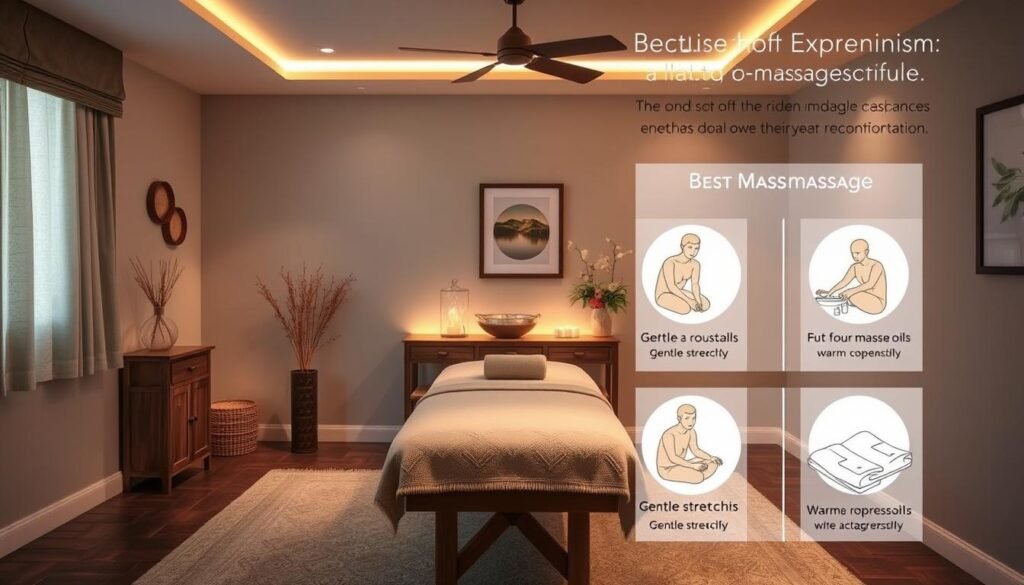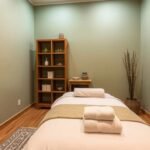Ever felt sore after a relaxing massage? Don’t worry! This discomfort often means your body is responding well. Let’s explore why your massage hurts after and how to handle it.
Post-massage soreness is common and usually fades within 36 hours. It’s a sign your body is healing. This discomfort comes from muscle manipulation and tension release.
Muscle tension, dehydration, and personal sensitivity affect how you feel after a massage. Staying hydrated before and after can help reduce soreness. It also speeds up recovery12.
Talk openly with your massage therapist about your comfort levels. Share any concerns you have. This helps you get the most from your massage while managing discomfort1.
Key Takeaways
- Post-massage soreness is normal and typically short-lived
- Hydration plays a crucial role in reducing discomfort
- Different massage types can lead to varying levels of soreness
- Gentle stretching and light exercise can aid recovery
- Open communication with your therapist is essential
- Heat and cold therapy can provide relief
- Seek medical advice if pain persists unusually long
Understanding Post-Massage Soreness and Discomfort
Post-massage soreness often occurs after deep tissue or sports massages. This discomfort usually means your muscles are responding to treatment. It’s a normal part of the healing process.
Normal vs. Concerning Massage Pain
Normal post-massage soreness feels like post-workout aches. It typically lasts 24-36 hours. Aching muscles, tenderness, and tightness are common symptoms3.
Deep tissue massage recovery often involves this type of soreness45. New massage recipients are more likely to experience these effects.
Concerning pain is severe, long-lasting, or comes with bruising. Consult a doctor if discomfort persists for more than a few days3.
Duration of Post-Massage Soreness
Post-massage soreness duration depends on several factors:
- Massage intensity
- Individual sensitivity
- Frequency of treatments
Soreness can last from a few hours to a few days3. Regular deep tissue or sports massage recipients may experience fewer negative effects4.
Impact of Different Massage Types
Different massage types affect soreness levels:
| Massage Type | Soreness Level | Recovery Time |
|---|---|---|
| Swedish | Low | Quick |
| Deep Tissue | High | Longer |
| Sports | Moderate to High | Variable |
Swedish massages are generally gentler. Deep tissue and sports massages may cause more discomfort. Remedial and sports massages often lead to muscle aches4.
Talk to your massage therapist about managing post-massage soreness. Good communication ensures a comfortable experience3. Understanding these factors helps you prepare for massage side effects.
Why Massage Hurts After: Common Causes and Explanations

Sore muscles after a massage can be puzzling. Let’s explore the reasons behind post-massage pain. Understanding this can help you manage any discomfort better.
Muscle Manipulation and Inflammation
Massage therapy works by manipulating muscles, which can cause temporary inflammation. This is part of your body’s natural healing process. About 10% of massage patients feel minor discomfort the next day6.
This soreness is similar to what you might feel after a workout. It shows that your muscles are adapting and recovering.
Breaking Down Adhesions and Knots
Deep tissue massages target muscle knots and adhesions. Therapists apply pressure to break down these tight areas. This process can be uncomfortable.
The discomfort you feel means the massage is working to release tension. However, a good massage shouldn’t cause unbearable pain7.
Individual Sensitivity Factors
Your personal sensitivity affects how you experience post-massage soreness. Factors like hydration, overall health, and muscle tension play a role. Some people may feel more tender than others after a massage.
Interestingly, 23% of massage patients report unexpected benefits unrelated to aches or pains6.
Good aftercare can help reduce discomfort. Try drinking water, taking a warm bath, and gentle stretching. Remember, some soreness is normal, but severe pain isn’t.
Always talk to your massage therapist about your comfort level. This ensures you have a positive experience.
Types of Massage and Their Pain Levels

Massage therapy offers various techniques with unique benefits and discomfort levels. Knowing these differences helps you pick the right massage for your needs. It also prepares you for any soreness after treatment.
Deep Tissue vs. Swedish Massage
Deep tissue massages target chronic muscle tension and knots. These sessions last 60 to 120 minutes and may need 24 to 48 hours for recovery8.
Swedish massage is gentler and perfect for beginners or those sensitive to pain8. It’s the most requested massage type, focusing on relaxation and overall well-being9.
Sports and Therapeutic Massage Effects
Sports massages boost athletic performance by improving circulation, flexibility, and endurance8. They help with chronic pain in specific muscles due to repetitive use or multiple injuries9.
Therapeutic massages, like hot stone treatments, loosen tight muscles without heavy pressure. They’re great for deep tissue massage recovery without intense discomfort8.
Choosing the Right Massage Intensity
Your pain tolerance and health goals determine the best massage intensity for you. Different types of massage offer various benefits.
Aromatherapy massages use essential oils to boost mood and ease tension. Shiatsu can improve digestion and relieve headaches9.
| Massage Type | Pain Level | Recovery Time | Best For |
|---|---|---|---|
| Deep Tissue | High | 24-48 hours | Chronic tension |
| Swedish | Low | Minimal | Relaxation |
| Sports | Moderate to High | Varies | Athletic performance |
| Hot Stone | Low to Moderate | Minimal | Muscle relaxation |
Massage therapy aftercare is key to reducing massage-related pain. Some soreness is normal but shouldn’t last more than 2 days10.
Always share your health history and concerns with your therapist. This ensures the most appropriate and beneficial treatment for you.
Essential Post-Massage Recovery Tips
Recovery after a massage is vital to maximize benefits and manage discomfort. Hydration is key. Drink at least six to eight glasses of water post-massage to flush toxins1112.
This helps reduce muscle soreness and aids in massage pain relief13. Gentle stretching can ease lingering tension. Be careful not to overdo it to avoid further discomfort1213.
Try heat therapy for soothing body aches. A warm bath or shower can relax sore muscles. It also enhances the massage’s effects12.
Your diet affects recovery too. Choose nutrient-rich foods like fruits, vegetables, and lean proteins. These anti-inflammatory foods can reduce muscle soreness1113.
Avoid alcohol and caffeine. They can interfere with the massage’s detoxifying effects12. Rest is crucial for recovery. Skip heavy physical activities for about 24 hours post-massage12.
If soreness persists, use over-the-counter pain relievers. They can promote movement and flexibility12. Talk openly with your massage therapist. This helps prevent future post-massage pain13.
FAQ
Is it normal for a massage to hurt after treatment?
How long does post-massage soreness typically last?
What’s the difference between normal and concerning post-massage pain?
Why do some massages cause more pain than others?
How can I minimize post-massage discomfort?
Can I take pain relievers for post-massage soreness?
Should I communicate with my massage therapist about post-massage pain?
How does dehydration affect post-massage soreness?
Can frequent massages reduce post-treatment soreness?
Source Links
- Sore After Massage: Why This Happens and What to Do – https://www.healthline.com/health/sore-after-massage
- Why Does My Body Feel Worse After a Massage? – https://health.clevelandclinic.org/why-does-my-body-feel-worse-after-a-massage
- Sore After A Massage? Tips For Relieving Post-Massage Soreness — Press Modern Massage – https://www.pressmodernmassage.com/blogs/going-deep/post-massage-soreness
- Sore After Massage? Why & Pain Managment | TMC Chiswick – https://www.tmc-chiswick.com/blog/why-am-i-so-sore-after-my-massage/
- Sore After a Massage? Why it Happens and What to Do | Massage Experts – Massage Experts – https://www.massageexperts.ca/blog/sore-after-a-massage-why-it-happens-and-what-to-do-massage-experts/
- What Could Possibly Go Wrong With Massage? – https://www.painscience.com/articles/massage-therapy-side-effects.php
- Why Do Massages Hurt? | The Anatomy Of A Good Massage – https://steppodiatry.co.uk/why-do-massages-hurt/
- Remedial vs Deep Tissue Massage – https://osim.com.au/blogs/wellness-hub/remedial-vs-deep-tissue-massage?srsltid=AfmBOoqyvAGLrcpS8P-l2mgQv6UxcPTprASvBD1Ml8bMyjKuu-BtTq_r
- 10 Types of Massage (& Why You May Need Them) – https://chiropractorinoviedo.com/blog/types-of-massage/
- Massage therapy guide – https://www.healthdirect.gov.au/massage-therapy
- Aftercare Remedial Massage Tips – Sport & Spinal Physiotherapy – https://sportandspinalphysio.com.au/9-aftercare-remedial-massage-tips/
- 7 aftercare tips to get the most from your massage – https://www.fulham-massage.com/blog/314-7-after-care-tips-to-get-the-most-from-your-massage
- Post-Massage Pain: Your Essential Self-Care Checklist | Everest Therapeutics – https://www.everesttherapeutics.com/benefits-of-massage/post-massage-pain-essential-self-care-checklist













2 Comments
Interesting read! But isnt the post-massage soreness similar to that experienced after an intense workout? Would love to hear your thoughts.
Interesting read, but wouldnt hydration post-massage help alleviate some of the soreness? Just a thought, open for discussion.